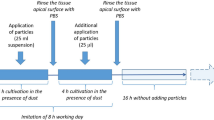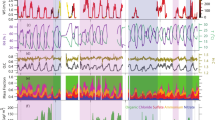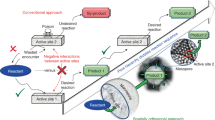Abstract
Occupational exposure to trichloroethylene (TRIC) and perchloroethylene (PERC) in metal degreasing is analyzed by calculating airborne concentrations for a large set of possible exposure scenarios (Scenario-Based Risk Assessment, SceBRA). Different types of degreasing machines ranging from open-top machines used until the 1980s to closed-loop nonvented machines used since the 1990s are investigated; the scope of the study is Germany. Concentrations are calculated for different kinds of releases (emissions from open baths, leakage, release of contaminated air during loading and unloading) with a dynamic two-box model for the near-field and the far-field. The concentration estimates are in good agreement with measured data. The airborne concentrations are compared to maximum workplace concentrations (MAK values). The full set of scenarios shows for which situations MAK values were exceeded and how the transition to newer degreasing machines reduced the occupational exposure by more than one order of magnitude. In addition, numbers of exposed workers are estimated for different years. While more than 25,000 workers in the near-field were exposed to TRIC and PERC in 1985, the number is below 3000 since 1996, which is mainly due to technology changes, rationalization, automatization, and replacement of TRIC and PERC by nonchlorinated solvents.
Similar content being viewed by others
Login or create a free account to read this content
Gain free access to this article, as well as selected content from this journal and more on nature.com
or
References
Adams, H.-N. Metallentfettung mit CKW-Lösemitteln und Ersatzstoffe und alternative Technologien in diesem Anwendungsbereich. Enquete-Kommission “Schutz des Menschen und der Umwelt”, Stellungnahme der Sachverständigen zu dem Fragenkatalog für die öffentliche Anhörung am 3. und 4. Juni 1993 zu dem Thema “Chlorchemie”, pp. 3–118. Deutscher Bundestag Enquete-Kommission Bonn, 1993.
Adams, H.-N. Entwicklung CKW-Lösemittel Markt. Dow Europe S.A., Horgen, 1997, pp. 1–17.
Adams, H.-N., and Jeker, H. The Influence of BIMSCH on the Degreasing Equipment Used in Germany and on the Solvent Con-sumption — Estimation. Dow Europe S.A., Horgue 1986, pp. 1–12.
Bach, H., Becher, K., Biegert, B., Detzer, R., Diebschlag, W., Dittes, W., Hocke, M., Jungbäck, E., Madjidi, M. and Scholer, W. Gezielte Belüftung der Arbeitsbereiche in Produktionshallen zum Abbau der Schadstoffbelastung, pp. 1–157. Bundesministerium für Forschung und Technologie (BMFT), Bonn, 1992.
Bardodej, Z. and Vyskocil, J. Arch Ind Hyg Occup Med 1956: 13: 581.
BImSchV. Zweite Verordnung zur Durchführung des Bundes-Immissionsschutzgesetzes (Verordnung zur Emissionsbegrenzung von leichtflüchtigen Halogenkohlenwasserstoffen — 2. BImSchV). 21 April 1986.
BImSchV. Zweite Verordnung zur Durchführung des Bundes-Immissionsschutzgesetzes (Verordnung zur Emissionsbegrenzung von leichtflüchtigen Halogenkohlenwasserstoffen — 2. BImSchV). 10 December 1990.
BImSchV. Gesetzesnovelle vom 21.8.2001 gemäss Art. 2 VO zu: Zweite Verordnung zur Durchführung des Bundes-Immissionsschutzgesetzes (Verordnung zur Emissionsbegrenzung von leichtflüchtigen Halogenkohlenwasserstoffen — 2. BImSchV). 21 August 2001.
BK-Report. Polyneuropathie oder Enzephalopathie durch organische Lösemittel oder deren Gemische, pp. 1–10. BK, BIA, 1999.
Bock, W., Brock, T.H., Stamm, R. and Wittneben, V. BGAA-Report (Berufsgenossenschaftlicher Arbeitskreis Altstoffe), Altstoffe — Expositionen am Arbeitsplatz, pp. 1–105. Hauptverband der gewerblichen Berufsgenossenschaften (HVBG), Sankt Augustin, 1999.
BUA. Trichlorethen, BUA-Stoffbericht 95 (Stand: Juni 1991). Hirzel Verlag, Stuttgart, 1993, pp. 1–398.
BUA. Tetrachlorethen (PER), BUA-Stoffbericht 139. Hirzel Verlag, Stuttgart, 1994, pp. 1–366.
CEFIC. Trichloroethylene in metal cleaning and other industrial applications, pp. 1–18. CEFIC, Conseil Européen de l'Industrie Chimique, Brussel, 1984.
Cercl'Air. Massnahmen zur Verringerung der Umweltbelastung beim Reinigen und Entfetten von Metallen (VOC-Kommission), pp. 1–67. Amt für Umweltschutz, Glarus; Schweizerische Gesellschaft der Lufthygieniker in Zusammenarbeit der Eduard-Stählin-Organisation, Glarus, 1993.
Cherrie, J.W., Schneider, T., Spankie, S. and Quinn, M. A new method for structured, subjective assessments of past concentrations. Occup Hyg 1996: 3: 75–83.
Drivas, P.J., Simmonds, P.G. and Shair, F.H. Experimental characterization of ventilation systems in buildings. Environ Sci Technol 1972: 6(7): 609–614.
ECETOC. Trichloroethylene: assessment of human carcinogenic hazard. Technical report no. 60, pp. 1–77. ECETOC, Brussels, 1994.
ECETOC. Joint assessment of commodity chemicals no 39: tetrachloro-ethylene CAS no. 127-18-4, pp. 1–271. ECETOC, Brussels, 1999.
Fehrenbacher, M.C. and Hummel, A.A. Evaluation of the mass balance model used by the Environmental Protection Agency for estimating inhalation exposure to new chemical substances. Am Ind Hyg Assoc J 1996: 57: 526–536.
Flynn, M.R., and Sills, E.D. On the use of computational fluid dynamics in the prediction and control of exposure to airborne contaminants — an illustration using spray painting. Ann Occup Hyg 2000: 44(3): 191–202.
Franke, J.E., and Wadden, R.A. Indoor contaminant emission rates characterized by source activity factors. Environ Sci Technol 1987: 21(1): 45–51.
Furtaw, E.J., Pandian, M.D., Nelson, D.R., and Behar, J.V. Modeling indoor air concentrations near emission sources in imperfectly mixed rooms. J Air Waste Manage Assoc 1996: 46: 861–868.
Gmehling, J., Weidlich, U., Lehmann, E., and Fröhlich, N. Verfahren zur Berechnung von Luftkonzentrationen bei Freisetzung von Stoffen aus flüssigen Produktgemischen. Staub - Reinhalt Luft 1989: 49: 227–230 and 295–299.
Grandjean, E., Münchinger, R., and Turrian, V. Investigations into the effects of exposure to trichloroethylene in mechanical engineering. Br J Ind Med 1955: 12: 131–142.
Hayes, S.R. Use of an indoor air quality model (IAQM) to estimate indoor ozone levels. J Air Waste Manage Assoc 1991: 41: 161–170.
Heinsohn, R.J. Industrial Ventilation: Engineering Principles. Wiley-Interscience Publication, New York, 1991.
Jayjock, M.A. Assessment of inhalation exposure potential from vapors in the workplace. Am Ind Hyg Assoc J 1988: 49(8): 380–385.
Jayjock, M.A., and Hawkins, N.C. A proposal for improving the role of exposure modeling in risk assessment. Am Ind Hyg Assoc J 1993: 54(12): 733–741.
Keil, C.B. The development and evaluation of an emission factor for a toluene parts-washing process. Am Ind Hyg Assoc J 1998: 59: 14–19.
Keil, C.B. A tiered approach to deterministic models for indoor air exposure. Appl Occup Environ Hyg 2000: 15(1): 145–151.
Leisewitz, A. and Schwarz, W. Metalloberflächenreinigung mit CKW, KW und wässrigen Reinigern. Stoffstromanalyse und Umweltbelastungsvergleich, pp. 1–324. Umweltbundesamt, 1994.
Mannheim, R., Budelmann, C. and Winkel, P. Ersatzstoff für Trichlorethylen bei der Entfettung metallischer Oberflächen, pp. 1–151. Siemens AG Berlin, im Auftrag des Umweltbundesamtes, Berlin, 1979.
Manufacturers. Sales brochures and information of metal degreasing machines provided by PERO, ROLL, FISA, DÜRR, MULTIMATIC, HÖCKH, ILSA and EMO. 1960–2001.
Matthiessen, R.C. Estimating chemical exposure levels in the workplace. Chem Eng Prog 1986: 30–34.
Morse, K.M., and Goldberg, L. Chlorinated solvent exposures. Ind Med 1943: 12: 706–713.
Nader, F.W. Stellungnahme zu Fragenkatalog Nr. 2 Chlorkohlenwasserstoffe. In: Enquete-Kommission “Schutz des Menschen und der Umwelt” Stellungnahme der Sachverständigen zu dem Fragenkatalog für die öffentliche Anhörung am 3. und 4. Juni 1993 zu dem Thema “Chlorchemie”, pp. 193–234. Deutscher Bundestag Enquete-Kommission Bonn, 1993.
Nader, F.W. CKW-Lösemittel-Markt. VCI, 2000.
Nader, F.W. VCI survey of German metal degreasers using TRIC. Frankfurt, 2001.
Nader, F.W. CKW-Lösemittel-Markt (Frischware) Bundesrepublik Deutschland, pp. 1–3. VCI, Frankfurt, 2002.
Neghab, M., Qu, S., and Bai, C.L. Raised concentrations of serum bile acids following occupational exposure to halogenated solvents, 1,1,2-trichloro-1,2,2-trifluoroethane and trichloroethylene. Int Arch Occup Environ Health 1997: 70: 187–194.
Nicas, M. Estimating exposure intensity in an imperfectly mixed room. Am Ind Hyg Assoc J 1996: 57: 542–550.
Nicas, M., and Jayjock, M.A. Uncertainty in exposure estimates made by modeling versus monitoring. Am Ind Hyg Assoc J 2002: 63: 275–283.
Nicholson, G.P., Clark, R.P., and De Calcina-Goff, M.L. Computational fluid dynamics as a method for assessing fume cupboard performance. Ann Occup Hyg 2000: 44(3): 203–217.
Nicklin, H.G. Arbeitshygienische Gesichtspunkte beim Einsatz von chlorierten Lösemitteln in Reinigungsverfahren, Vol. 11, pp. 1–8. Die Berufsgenossenschaft, 1972.
Niemann, S. Effizienz von Arbeitsschutzmassnahmen bei einem Perchlorethylen-belasteten Kollektiv. Universität Hamburg, Hamburg, 1995, pp. 1–18.
OECD. SIDS initial assessment report for the 5th SIAM, tetrachloro-ethylene. OECD (Organisation for Economic Co-operation and Development), Paris, 1996.
Raaschou-Nielsen, O., Hansen, J., Thomsen, B.L., Johansen, I., Lipworth, L., McLaughlin, J.K., and Olsen, J.H. Exposure of Danish workers to trichloroethylene, 1947–1989. Appl Occup Environ Hyg 2002: 17(10): 693–703.
Rantala, K., Riiginen, H. and Anttila, A. Altisteetyössä, 22 halogeenihiitivedyt [exposure at work, 22 halogenated hydrocarbons]. Finnish Institute of Occupational Health, Helsinki, 1992.
Recknagel, H., Sprenger, E. and Schramek, E.R. Taschenbuch für Heizung und Klimatechnik. R. Oldenbourg Verlag, München, 2000.
Ryan, P.B., Spengler, J.D., and Halpfenny, P.F. Sequential box models for indoor air quality: application to airliner cabin air quality. Atmos Environ 1988: 22(6): 1031–1038.
Scheff, P.A., Friedman, R.L., Franke, J.E., Conroy, L.M., and Wadden, R.A. Source activity modeling of freon® emissions from open-top vapor degreasers. Appl Occup Environ Hyg 1992: 7(2): 127–134.
Scheringer, M., Vögl, T., von Grote, J., Capaul, B., Schubert, R., and Hungerbühler, K. Scenario-based risk assessment of multi-use chemicals — application to solvents. Risk Anal 2001: 21(3): 481–497.
Sohn, M.D., and Small, M.J. Parameter estimation of unknown air exchange rates and effective mixing volumes from tracer gas measurements for complex multi-zone indoor air models. Building Environ 1999: 34: 293–303.
Thoulass, R. Occupational Hygiene Report: Workplace personal exposure to tetrachloroethene (perchloroethylene) during the use of modern metal cleaning equipment, pp. 1–10. 1998.
Wadden, R.A., Hawkins, J.L., Scheff, P.A., and Franke, J.E. Characterization of emission factors related to source activity for trichloroethylene degreasing and chrome plating processes. Am Ind Hyg Assoc J 1991: 52(9): 349–356.
Wadden, R.A., Scheff, P.A., and Franke, J.E. Emission factors for trichloroethylene vapor degreasers. Am Ind Hyg Assoc J 1989: 50(9): 496–500.
Wadden, R.A., Scheff, P.A., Franke, J.E., Conroy, L.M., Javor, M., Keil, C.B., and Milz, S.A. VOC emission rates and emission factors for a sheetfed offset printing shop. Am Ind Hyg Assoc J 1995: 56: 368–376.
Acknowledgements
We thank Dow Europe S.A., the Swiss Reinsurance Company, and the Swiss Federal Office of Public Health (BAG) for financial support of this study. Thanks go to H.-N. Adams, Dow Europe, and Jörg Pastré for helpful discussions.
Author information
Authors and Affiliations
Corresponding author
Rights and permissions
About this article
Cite this article
von Grote, J., Hürlimann, C., Scheringer, M. et al. Reduction of occupational exposure to perchloroethylene and trichloroethylene in metal degreasing over the last 30 years: influences of technology innovation and legislation. J Expo Sci Environ Epidemiol 13, 325–340 (2003). https://doi.org/10.1038/sj.jea.7500288
Received:
Accepted:
Published:
Issue Date:
DOI: https://doi.org/10.1038/sj.jea.7500288
Keywords
This article is cited by
-
Study on the community structure and function of anaerobic granular sludge under trichloroethylene stress
Ecotoxicology (2021)
-
Local risks and global impacts considering plant-specific functions and constraints: a case study of metal parts cleaning
The International Journal of Life Cycle Assessment (2010)



